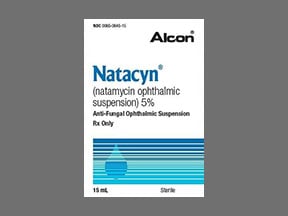
Natacyn Coupons & Savings Card – Discount Prices from $947.55
My prescription
Edit
15ML of 5%, Natacyn (1 Bottle)
Select pharmacy

CVS
$947.55
COUPON PRICE
Walmart
$964.00
COUPON PRICE
Albertsons
$964.08
COUPON PRICE
Walgreens
$974.99
COUPON PRICEFree Natacyn Savings Card

CVS
$947.55
Show this coupon to your pharmacist
ID
LH53BE5F9F
PCN
CHIPPO
BIN
019876
GRP
LHX
This coupon is not insurance
Price history for Natacyn
1 Bottle, 15ML of 5%
Average retail price for Natacyn
Average SaveHealth price for Natacyn
Our price history data is based on aggregated prescription data collected from participating pharmacies in America. Our prescription data updates daily to reflect the latest price changes. If you notice a missing data point, it means there wasn't sufficient data available to generate a monetary value for that date.
*Retail prices are based on pharmacy claims data, and may not be accurate when we don't have enough claims.
Natacyn dosage forms
Dosage Quantity Price from Per unit 15ML of 5% 1 Bottle $947.55 $947.55 15ML of 5% 2 Bottles $1907.10 $953.55 15ML of 5% 3 Bottles $2866.64 $955.55
| Dosage | Quantity | Price from | Per unit |
|---|---|---|---|
| 15ML of 5% | 1 Bottle | $947.55 | $947.55 |
| 15ML of 5% | 2 Bottles | $1907.10 | $953.55 |
| 15ML of 5% | 3 Bottles | $2866.64 | $955.55 |
Natacyn Warnings
The following information outlines essential safety precautions and potential risks associated with the use of Natacyn (natamycin) eye drops. Please ensure you review these details thoroughly and discuss any concerns with your healthcare provider.
Regular Monitoring and Follow-Up: It is crucial to have regular follow-up appointments with your healthcare provider to monitor the progress of your eye infection while using Natacyn (natamycin). These appointments help determine the duration of treatment and whether a different medication may be more suitable. If your corneal infection does not show improvement after 7 to 10 days of treatment, additional testing and a potential change in medication might be necessary.
Medication Buildup: You may observe an accumulation of the medication around an eye ulcer or along the top or bottom edges of the eye. This is generally normal; however, notify your healthcare provider if it causes irritation or affects your vision.
There are currently no known contraindications for Natacyn (natamycin). Always consult with your healthcare provider to ensure this medication is appropriate for your condition.
Natacyn Side Effects
When using this medication, some individuals may experience common side effects related to the eyes. These include discomfort, irritation, swelling, redness, pain, watery eyes, or a sensation as if something is in the eye. Occasionally, users might notice a cloudy eye surface or experience changes in vision. These effects are typically mild, but if they persist or worsen, it's advisable to consult your healthcare provider for guidance. In some cases, you might notice unusual sensations such as pins and needles, or experience chest pain and shortness of breath. While these occurrences are less common, they warrant attention and should be discussed with a healthcare provider if they occur. Though rare, serious allergic reactions can occur. Signs of a severe reaction include rash, itching or swelling particularly around the face, tongue, or throat, severe dizziness, and trouble breathing. If you notice any of these symptoms, seek medical attention immediately. Always be vigilant for any other side effects not listed here and consult your healthcare professional if you encounter any unusual symptoms.
Natacyn Interactions
What is the drug natamycin used for?
Natamycin is an antifungal medication used to treat fungal infections, particularly those affecting the eyes. It is commonly prescribed for conditions such as fungal keratitis and conjunctivitis.
What are the side effects of Natamycin eye drops?
Natamycin eye drops can cause some side effects, although not everyone will experience them. Common side effects may include mild eye irritation, redness, or discomfort. Less commonly, individuals might experience blurred vision, eye pain, or an allergic reaction. If any severe or persistent side effects occur, it is important to contact a healthcare provider.
What is the indication of Natacyn?
Natacyn is indicated for the treatment of fungal infections of the eye, specifically fungal keratitis.
What is the route of Natamycin?
Natamycin is typically administered via the ophthalmic route as eye drops for treating fungal infections of the eye.
What is the mechanism of action of natamycin?
Natamycin works by binding to ergosterol, a key component of fungal cell membranes. This binding disrupts the membrane's integrity, leading to increased permeability and ultimately causing cell death. It is effective against a variety of fungi, particularly yeasts and molds.
